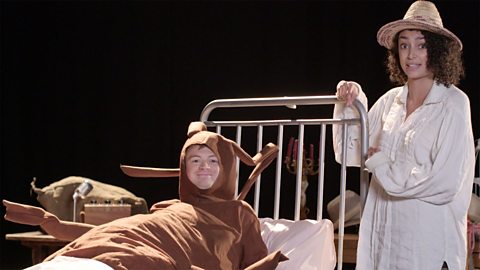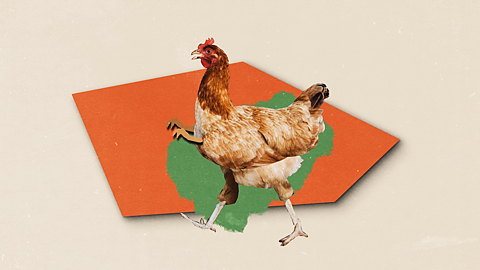True or False?
A story can start at the beginning.
A story can start at the end.
A story can start in the middle.
Answer: All true.
It is up to the writer to choose!
Introduction to using structure for effect
Narrative structure in fiction refers to how a story is ordered and shaped. Cliff-hangers, plot twists, dramatic beginnings, endings which explain absolutely everything, stories that start (or end) with a bang т these are all choices a writer can make when they decide how to shape and order their story.
Two of the most important choices are:
- how to order the events in a story
- who is telling the story
For example, the events in a story may be ordered in a very logical, linear narrativeWhere the story is told in the order it happens, like a straight line. way or a non-linear way where the story jumps around in time т perhaps starting in the middle of the story or jumping into the past or future.
A story may also be told from different narrative perspectiveFrom whose point of view the story is told. so we may see the story through the eyes of only one character or look down on the whole story knowing everything all the characters are doing, feeling and saying.
Video about how to shape a story for effect
Learn how to shape your stories in order to create an emotional response in a reader
Putting events into order
Writers structure their stories by choosing the sequence in which narrative elements will be revealed to the reader.
A linear or chronologicalFollowing the time order in which events happened. structure is where the story is told in the order it happens. With a chronological or linear structure, the reader finds out what happens in the тcorrectт order т this can lead the reader through events clearly. It may not be the most interesting way to tell a story, though. You could use a non-linear structure where flashbacks show the reader a past event, gradually revealing details that have an impact on the plot.
In The Woman in Black by Susan Hill the narrator moves through different time periods to tell the story. This structure is used by Hill to build tension, as the narrator at the start knows how the story will unfold and can flash back and flash forward to control the readerтs knowledge. A non-linear story could begin at any point т somewhere in the middle, at the climax, or even at the end.
Both linear and non-linear structures are influenced by the narratorтs point of view.
Using a circular structure
In a circular narrative, the last section (or even just the last line) of a piece of writing takes you back to the beginning. For example, in the novel The Wonderful Wizard of Oz, Dorothy is whisked away from her home by a tornado and eventually, after a series of adventures, returns home т a place she now truly appreciates. Here the circular narrative creates a neat, happy ending, but it can equally be used to disturbing effect.
A circular ending is often used by writers to create a contrast between what was happening at the beginning and what was happening at the end т perhaps nothing has changed, perhaps it has changed for the better, or, worse. For example, in George Orwellтs Animal Farm, the novel ends as it began, with the animals on the farm being treated badly by a cruel leader. At the beginning it was the farmer and at the end it was a fellow animal т which seems even worse!

Why is this a circular narrative?
Read the opening and ending to this short story, Forbidden Fruit by Roshani Chokshi.
The Opening
Do not trust the fruit of Maria Makiling.
If you find your pockets full of thorny fruit, throw it out the window. Do not taste it. Do not stroke the rind and wonder at the impossible pink of its colour . . .
Fill your pockets with salt. Turn your shirt inside out. Tell Maria you have taken nothing.
The Ending
That is why you must turn your clothes inside out.
That is why you must empty your pockets of fruit.
For the Mountain does not like you to take things that do not belong to you.
Why is this a circular narrative?
This is a circular narrative because both the opening and the ending share similar ideas and language.
You probably noticed that both the opening and ending give instructions: not to take anything, to get rid of any fruit and to turn clothing inside out.
Narrative perspective
Narrative perspective is the point of view from which the story is told. There are two that are the most common in fiction.
First-person perspective
First-person perspective is where a character from the story tells the story. This involves using тIт or тweт in the narration. The advantage of this structure is that the reader can empathise and identify with the narrator т sometimes it can feel as if we become them. Using first-person perspective, a writer can choose to limit or reveal information based on what the character does or doesnтt know. This can be very effective in creating mystery and suspense.
In Blade: Playing Dead, Tim Bowler uses a first-person perspective to help the reader understand the narratorтs point of view:
You probably want to know my name. Well, that's a bit of a problem. I got loads. But, there is one name I like. Everybody called me it in the old days. No one does now cos no one in this city knows it. And that's fine. I don't like to remember. But, I do like the name. You can use it if you want. BLADE.
Third-person perspective
Third-person perspective is where the story is told about the characters. Using third-person perspective often means the reader can picture the whole scene as though it is being told through the eyes of an outsider. It uses тheт or тsheт or тtheyт to tell the story. Third-person perspective views events from the outside in. It allows the writer to follow whichever character they choose. The advantage of this is that the narrator is separated from the action and can reveal to the reader what any, or all, of the characters are thinking.
In Lord of the Flies, William Golding describes two of his characters in the first chapter:
Ralph disentangled himself cautiously and stole away through the branches. In a few seconds the fat boy's grunts were behind him and he was hurrying toward the screen that still lay between him and the lagoon. He climbed over a broken trunk and was out of the jungle.
Here, third-person perspective enables the reader to get an idea about the characteristics and appearance of both characters т Ralph and the тfat boyт, Piggy.
Building tension
Writers use tension to keep a readerтs interest and keep the plot moving. Tension can be created effectively by building up suspense. As a writer you need to think about how to structure your story to build up this tension. There are several ways to do this, including:
Starting in the middle of the action т for example, a dramatic moment like a fight, an accident, an explosion, which only begins to be explained after the reader has lived through the action first.
Keeping some information back or only hinting at information т for example, only later revealing crucial information (like your hero is in fact a ghost!) or starting with vague description (тa figure appearedт rather than telling us straightaway it was Hettie the nosy neighbour).
Creating a plot twist т for example, something unexpected happens at the end or, even better, something unexpected happens but youтve already given hints in the story (a technique called foreshadowing).
Using a cliff-hanger т for example, leaving the reader on the edge of their seat at the end of a chapter, desperate to find out what happened next.

Which is false?
This is the opening to Following Frankenstein by Catherine Bruton:
тBurn the letters.т
Those were my Auntтs dying words.
Which of the following statements is false?
a) The writer keeps back information т the reader has lots of questions
b) The writer starts in the middle of a dramatic moment
c) The writer goes back into the past
Answer: b) It is not in the middle of a dramatic moment т we can tell because the second sentence is in the past tense: тThose were my Auntтs dying words.т
Key points
Remember
When planning and writing a story think about the order in which events will be revealed to the reader, as well as the perspective from which the story is told. Experiment with linear and non-linear structures, and with first-and third-person perspectives.
What kind of narrative voice will you create? Where will you begin the story in order to hook your reader? Notice how other writers build their stories.
There is no single right way to tell a story.
Test your knowledge
Play Bitesize secondary games. gamePlay Bitesize secondary games
Have fun playing science, maths, history, geography and language games.

More on Fiction writing
Find out more by working through a topic
- count7 of 8

- count1 of 8
